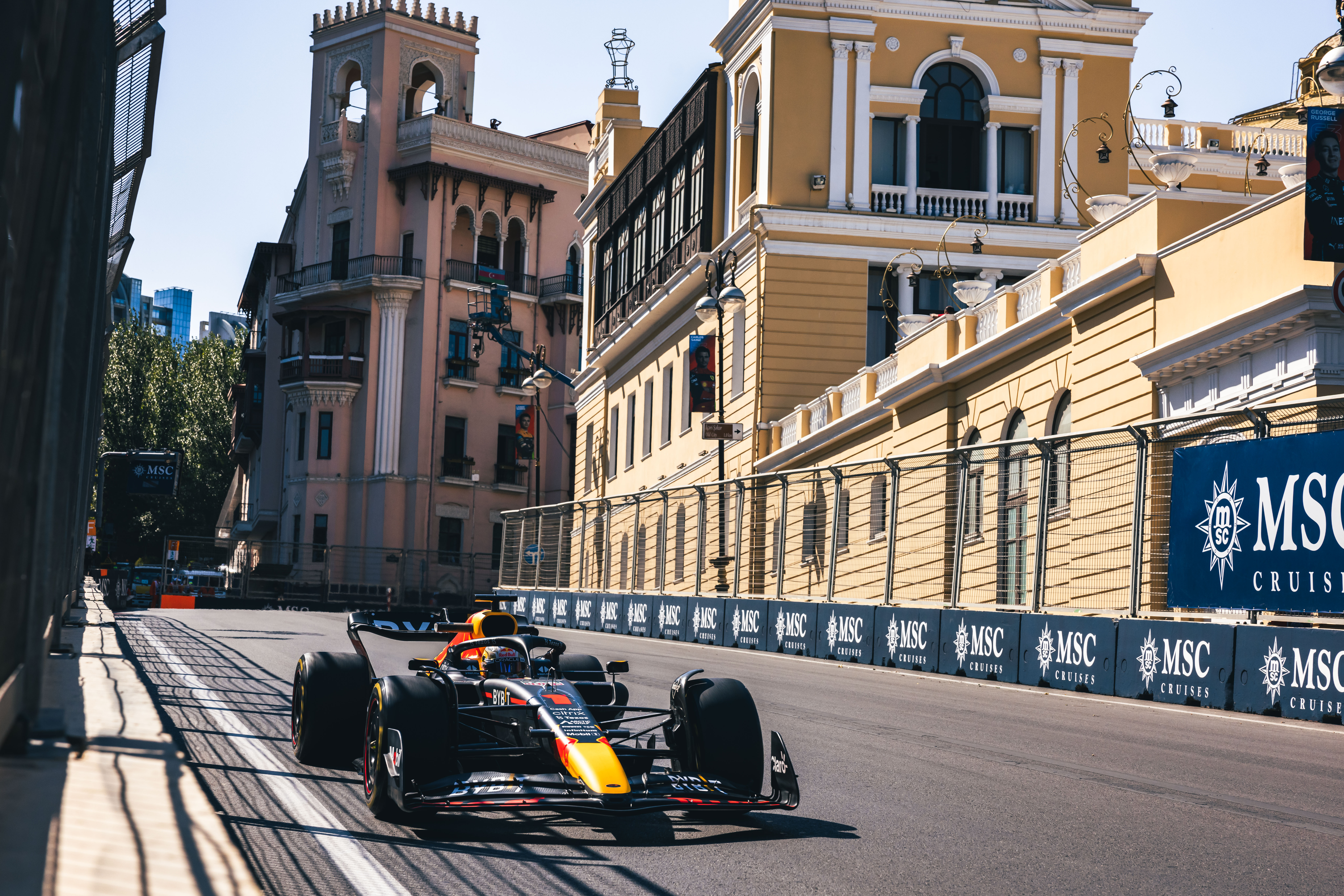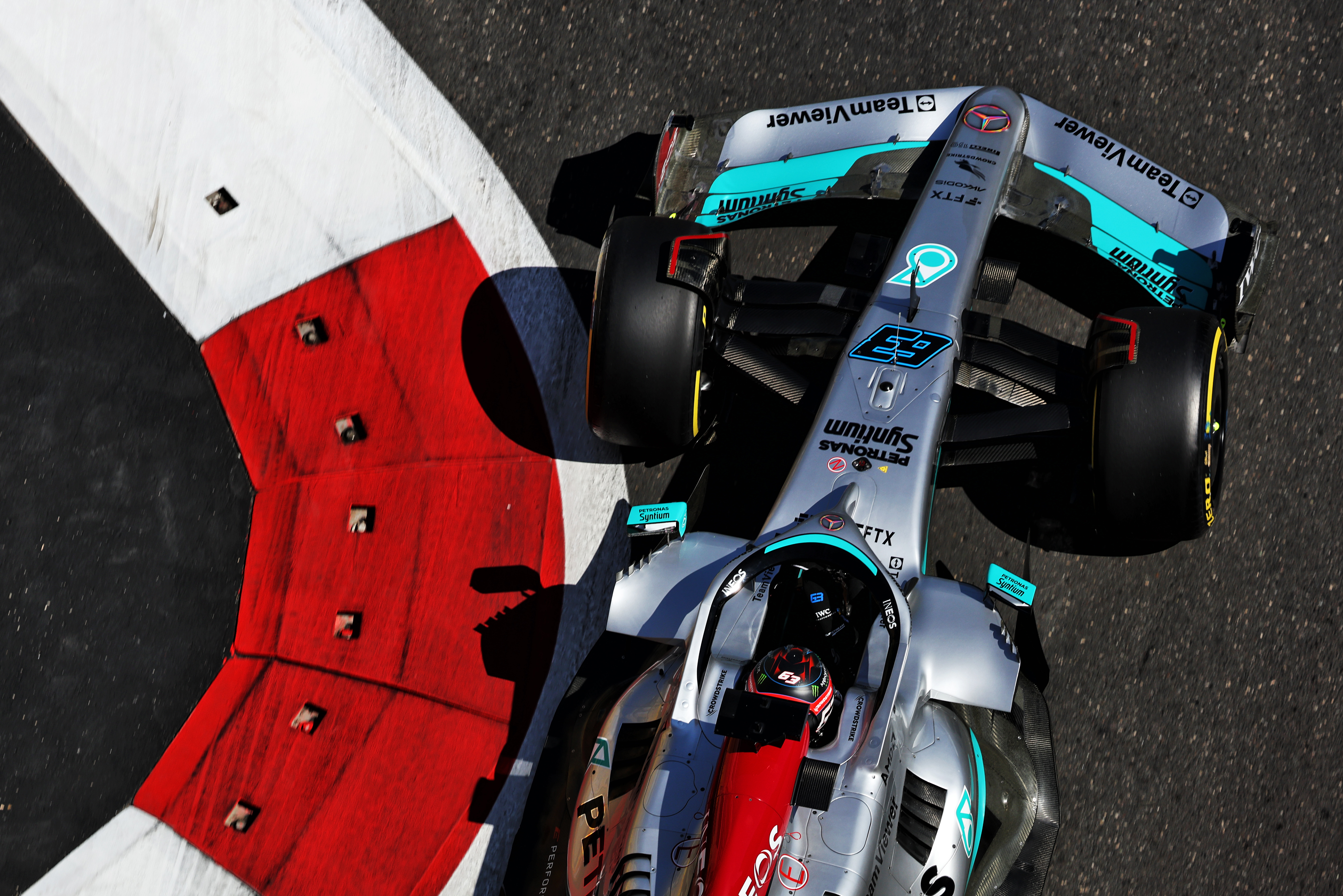A typically Baku day of choices, Friday saw teams trying to find the best downforce level for the polarising circuit layout and the best combination of tyre compounds around which to base the ideal strategy. Neither choice was clear.
Neither was the competitive order in this wild and windy place. Red Bull looked comfortably faster than Ferrari in the first session, as Sergio Perez took up where he left off in Monaco with scorching speed around a track on which he invariably shines.
But in the later session, as Ferrari switched to a lower downforce rear wing, the tables were apparently turned. The Ferrari was no longer giving away between two and three tenths in sector 3 to the Red Bull, as had been the case in FP1 – but was still super-quick in the tight twists and turns of the ‘Old Town’ middle sector.
The Red Bull remained the quickest at the end of the straight by a significant margin but for much of the length of it, there was little to choose between the two cars.
Around this long track where full ERS deployment is not available on-demand throughout the lap, part of the Red Bull’s end-of-straight advantage seemed to be coming from its power unit being able to deploy for longer. The Ferrari, as usual, was punching better out the corners, consistent with the theory that it is running a smaller, more responsive, turbo than its rival.
Max Verstappen had a quite troubled time, with an imbalance in the Red Bull and a fluttering DRS flap in FP1 – very like that which troubled last year’s Red Bull towards the end of the season.

In theory, this was a faster wing than that being used by Perez, with a more deeply dished section at the bottom of the flap. But the DRS mechanism was not strong enough to keep that flap fully open as the car neared its maximum speed. For the second session, Verstappen reverted to a Perez-spec wing, but was still dissatisfied with the car’s balance.
He spent a long time in the garage having adjustments made, so much so that he got in only three laps of long-running at the end of the session. He didn’t get to complete his ideal single lap on the soft tyre either – ironically because of yellow flags for team-mate Perez taking the Turn 15 escape road.
The best lap came on the third lap of his tyres around a track where the ultimate performance was coming on the first lap.
“Yes for once on a street circuit, we were getting the tyres to work straight away, I mean for everyone it looks like,” Verstappen said. “The Ferrari looks quick on a lap but thankfully on the long runs it looks a bit more even.”
Baku Friday long run pace
| 1 | Verstappen | 1m47.457s | 3 laps | softs |
| 2 | Leclerc | 1m47.779s | 7 laps | softs |
| 3 | Perez | 1m47.995s | 6 laps | mediums |
| 4 | Sainz | 1m48.091s | 6 laps | mediums |
| 5 | Hamilton | 1m49.377s | 6 laps | mediums |
| 6 | Russell | 1m49.495s | 8 laps | softs |
| 7 | Tsunoda | 1m49.743s | 7 laps | mediums |
| 8 | Vettel | 1m49.784s | 7 laps | mediums |
| 9 | Gasly | 1m49.821s | 6 laps | softs |
| 10 | Stroll | 1m50.221s | 7 laps | mediums |
Verstappen’s place at the head of those long-run times is flattered a lot by the short duration of his run on softs. Most teams split their long-running, with one car on mediums, the other on softs. Charles Leclerc’s average in the Ferrari on the softs is derived from a seven-lap run.
Comparing the medium-tyred runs of Sergio Perez with Carlos Sainz, it looks to be extremely close between the top two cars. Both are six-lap runs and they are separated by 0.096s, in Perez’s favour. The medium appears to be the slightly better tyre over a stint but the soft is holding up well enough that a one-stop strategy looks set to be the theoretical optimum.
“It didn’t go as well for us in the second session,” maintained Perez. “We were not able to sort out our problems, but we have the data, with both tyres in the long run. We’ll go through it tonight and hopefully we can pull it all together tomorrow.”
Ferrari ran the first session with its conventional rear wing but switched in FP2 to the lower-downforce version which first appeared in Miami but was not raced there.
The mainplane is less extravagantly spoon-shaped than the usual wing, with a straighter leading-edge and less underside surface. It seemed a very significant improvement, even allowing for Red Bull’s troubled second session. Leclerc’s best lap was over 0.25s clear of the field, whereas in the first session he’d lapped around 0.15s slower than Perez.
The second session fastest times were skewed somewhat by Perez’s turn 15 yellow flags as they denied both Verstappen and Sainz what would have been their best laps. As it was, a great tow from Lewis Hamilton helped Fernando Alonso’s updated Alpine with its new sidepods to fourth-fastest time.
“I don’t think anyone really got the ultimate lap in,” said Leclerc, “including us. But I am very encouraged that our pace in the long runs was good and the tyres seemed to be holding up well.”
Sainz emphasised just how tough the place is in the latest generation of cars, which are more physical in the slow corners, bounce you around down the straights yet still demand pinpoint accuracy to be quick without hitting the walls or getting caught out by the sudden gusts of wind.
All of these point towards the usual Baku incident-packed race day and, as such, the outcome may not lie in the last tenth of outright performance. The bouncing, aside from being physically uncomfortable, was making it difficult for Sainz to be fully confident on the brakes.

Visually, Ferrari, Red Bull and Mercedes seemed to have settled on a similarly low downforce level. Mercedes ran its low-downforce Miami wing throughout, but wing levels were not the major preoccupation of the team.
Much as expected, the same suspension-induced mechanical bouncing issues as experienced at Monaco were hurting its slow corner performance. This was contributing to the extreme bouncing seen at the end of the straights but didn’t require compromising on ride height. The Ferrari was also afflicted by the end-of-straight bouncing and the Merc’s lack of pace – it was 1.3s away – was in the slow corners and down the straights.
“I can’t tell you where 1.3s is,” said a somewhat despondent Lewis Hamilton. “A lot of it is on the straights.”
George Russell reckoned part of the problem was how the car was using the tyres. “You see with a number of drivers, their laps are coming right at the end of a run whereas Ferrari and Red Bull seem to be able to turn it on straight away. But that’s not everything. They’ve just got faster cars than us. Even if we were fully on top of the tyres that’s only 50% of our issue.”
With Montreal consisting of similarly slow corners to here and Monaco, Mercedes suspects it will be Silverstone before a Barcelona-level of performance will be within reach, when the mechanical limitation is less punishing. Around Baku, it will be a case of trying to qualify ahead of the midfield pack – with the most likely threats looking set to come from Alpine and AlphaTauri. The former is very strong on the straights, the latter good in slow corners.
Hamilton’s was the quicker Mercedes in FP1, Russell’s in the later session.
“We tried something experimental on our car in the second session,” said Hamilton, “which didn’t feel great to be honest and I think we will probably revert back for tomorrow.”





